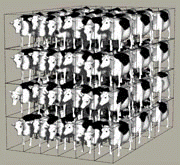Animal Science, Department of

World Congress on Genetics Applied to Livestock Production: 3rd (1986)
Date of this Version
1986
Abstract
The importance of the structure of the beef industry with respect to crossbreeding programs and division into cow-calf and feedlot segments; intensity of production with respect to market standards, feeds and labour; and resource constraints with respect to feed, labour, land and capital; are discussed and quantified where possible. The use of discounted gene flow provides estimates of relative expression rates which differ with crossbreeding programs and relative sizes of populations of purebred and commercial cattle. The importance of feedback from feedlot to cow-calf to purebred operation is emphasized, for both discounted expression rates and modelling approaches. The composition and quality of beef marketed, the influence of energy availability for cow herds and energy density of feedlot diets, and the level of management are discussed as important components of modelling beef production. The impact of resource constraints is discussed and an example is presented which shows the changes in selection decisions caused by changes in constraints. The situations under which selection decisions using linear programming would equal those from the use of a single equation to estimate breeding value for total merit are identified, as are some of those in which selections would differ. The implications of these differences in establishing breeding objectives are discussed.


Comments
Published in 3rd World Congress on Genetics Applied to Livestock Production, edited by Gordon E. Dickerson and Rodger K. Johnson, 4 vols. (Lincoln: University of Nebraska Institute of Agriculture and Natural Resources, 1986). Copyright © 1986 Board of Regents University of Nebraska.